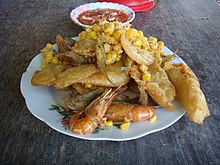|
Burmese fritters
Burmese fritters (Burmese: အကြော်; pronounced [ʔət͡ɕɔ̀]; known as a-kyaw in Burmese) are traditional fritters consisting of vegetables or seafood that have been battered and deep-fried. Assorted fritters are called a-kyaw-sone (Burmese: အကြော်စုံ). Burmese fritters are generally savory, and often use beans and pulses, similar to South Asian vada.  The fritters are eaten mainly at breakfast or as a snack at teatime, served at tea shops and hawker stands alike.[1] They are typically served as standalone snacks dipped in a sour-sweet tamarind-based sauce, or as toppings for common Burmese dishes. Gourd, chickpea and onion fritters are cut into small parts and eaten with mohinga, Myanmar's national dish. These fritters are also eaten with kauk hnyin baung rice and with a Burmese green sauce called a-chin-yay (အချဉ်ရည်). Depending on the fritter hawker, the sauce is made from chili sauce diluted with vinegar, water, cilantro, finely diced tomatoes, garlic and onions. Variations  Diced onions, chickpea, potatoes, a variety of leafy vegetables, brown bean paste, Burmese tofu, chayote, banana and crackling are other popular fritter ingredients. Typical Burmese fritters include:
Regional adaptationsEgg bhejo or egg bejo (Tamil: முட்டை பேஜோ or முட்டை பேஜோ) is a common Indian street snack of Burmese origin, consisting of hardboiled eggs stuffed with fried onions, garlic, coriander, and chilis and seasoned with tamarind and lemon juice.[8] The snack traditionally accompanies khow suey or atho,[9] both of which are adaptations of Burmese noodle salad and ohn no khao swè respectively. The term 'bhejo' is a corruption of Burmese 'pe kyaw' (ပဲကြော်), the fried split pea cracker that traditionally accompanies the aforementioned Burmese dishes. References
See alsoWikimedia Commons has media related to Burmese fritters.
|
||||||||||||||||

